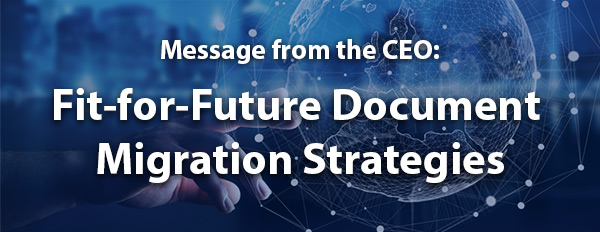|
How can you consolidate disparate existing document systems which have grown over years,
leading to redundancies, inefficiencies, and multiple efforts to maintain document templates
for different output channels? A question I get asked very often. Fragmented ownership and a
scattered landscape of too many general purpose and unsupported design tools are expensive to
maintain and often the primary barrier to successful customer engagement.
The migration project goals in the digital transformation roadmap are most effective when the
focus is on enterprise-wide harmonization and consolidation of existing documents for a
single-source approach
to document management. Delivering the same document content to
multiple output channels spanning print and digital, high-volume and ad-hoc documents, single
interactive business letters, and well-orchestrated digital messaging in real-time are more
necessary today than ever before.
Experience shows that fully automated one-to-one migrations are neither desired nor possible
due inconsistencies that have been established over years or even decades. Different document
and text definitions exist in multiple systems. Such redundancies and ambiguities in content
and business logic should be eliminated by consolidation of document templates, reducing
document text variants by introducing reusable building block templates. Even if the focus is
on consolidation rather than automation, there is always the option to automate using scripts
and tools we provide.
The migration will be worthwhile and most effective when the following goals are in focus:
- All documents, building blocks, business logic and processes are fully versioned
- Business teams manage documents and content in multiple languages for all output channels
- IT manages complex business logic and data reading routines
- Input data in any format and codepage can be read without modification or customization
- Deployment between DEV/TEST/PROD is controlled by implicit change & release management
- Reproduction of historical document versions with originally used resources
- Simulation of upcoming releases with time travel function
- Business logic can be defined by business departments via Natural Language Rules
- Grouping of building blocks to reduce reusable components
Migrations benefit from the Papyrus WebRepository platform with its Business Design tools
We have successfully migrated various document management systems, customer communication
applications or general purpose document and forms design products to the Papyrus platform,
which can run on premise, on physical or virtual machines or in the cloud. Our experience includes migrations to Papyrus
from MS Word/Visual Basic/Adobe/StreamServe/Doc1/OpenText/IBM ASF/DCF and others.
Request our Best Practices Migrations White Paper and learn more about strategies,
benefits, procedures, and planning a migration. Join engaging discussion and presentations on
migration topics and ‘Fit for Future’ business solutions at the
Global Open House Conference from 12 to 14 June
2022.
|
